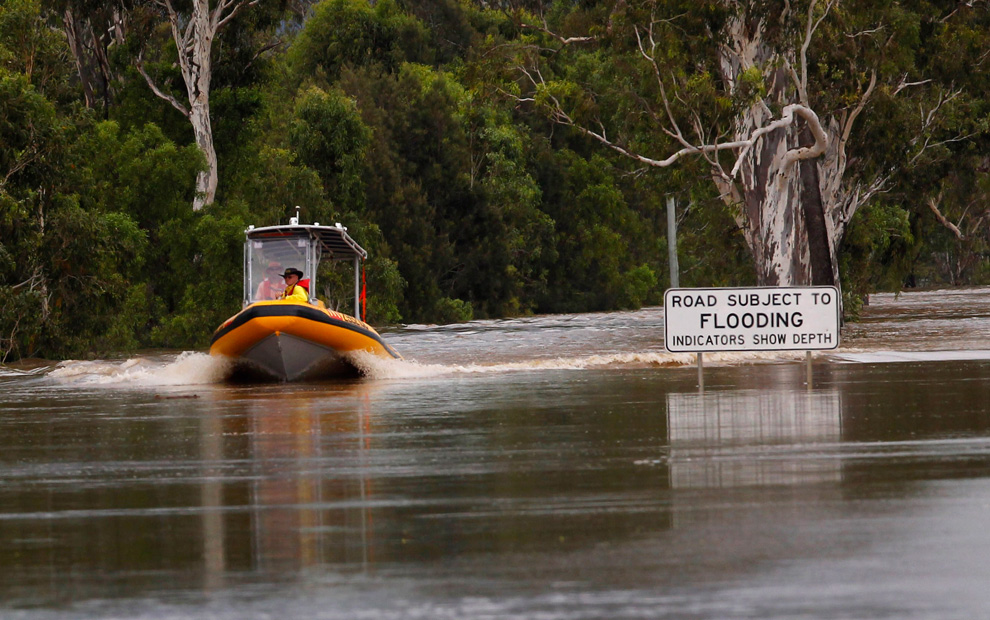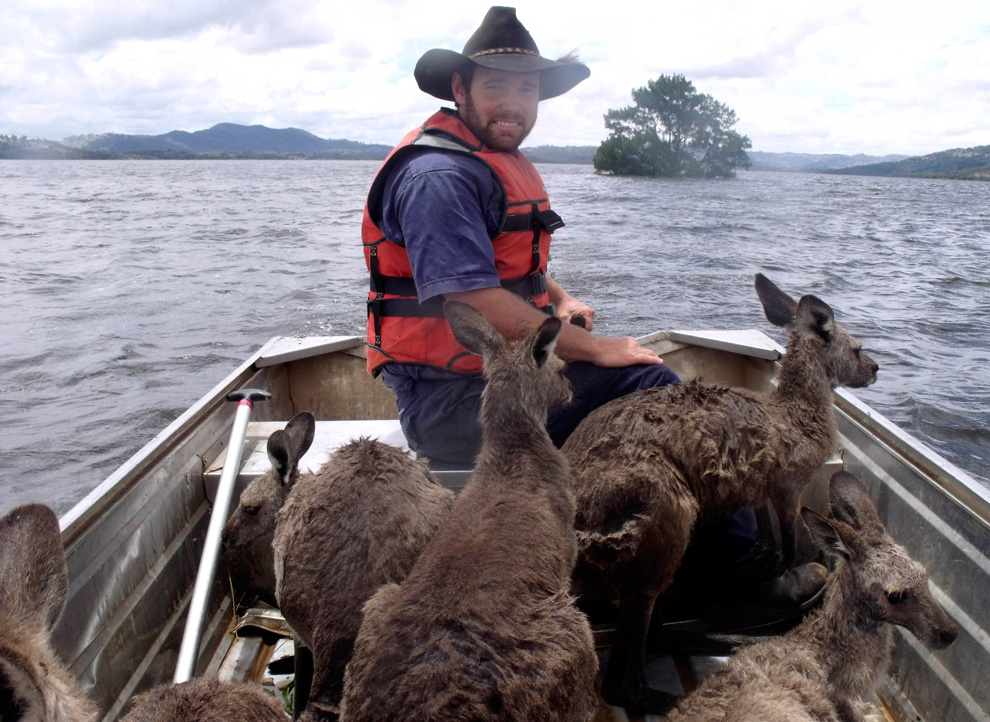Just thought I'd make a thread to bring this to people's attention. This is happening in Queensland, which is the state in the north east of Australia (near the Great Barrier Reef). The floods started last month and are still going. Here's an oldish article that conveys the size:
http://www.scientificamerican.com/article.cfm?id=australia-floods-cover-area-the-siz
It also looks like the floods are going to move south into New South Wales:
http://www.news.com.au/breaking-new...more-devastation/story-fn7ik2te-1225984710745
It was only a couple of years ago Queensland (and much of Australia) was in the middle of a crippling draught. I think at one stage they were talking about having to ship water in to south east Queensland because dam levels were only at 16% or something. Now this.
The poem was right:
http://www.scientificamerican.com/article.cfm?id=australia-floods-cover-area-the-siz
By Michael Perry
SYDNEY, Dec 31 (Reuters) - Flood water rose across Australia's northeast on Friday, covering an area bigger than France and Germany combined, inundating 22 towns and stranding 200,000 people, and closing one of the country's major sugar export ports.
Flooding has already shut major coal mines in Queensland state and its biggest coal export port, forcing a long list of miners such as Anglo American and Rio Tinto to slow or halt operations.
The worst flooding in about 50 years has been caused by a La Nina weather pattern which has resulted in torrential rain over the past two weeks across northeast Australia.
"This disaster is a long way from over," Queensland state premier Anna Bligh told reporters on Friday.
"We now have 22 towns or cities that are either substantially flooded or isolated. That represents some 200,000 people spanning an area that's bigger than the size of France and Germany combined," said Bligh.
Prime Minister Julia Gillard toured the flood-hit sugar city of Bundaberg, which closed its port on Friday after flood debris was washed downstream into shipping channels and damaged navigation beacons.
"This is a natural disaster across Queensland," said Gillard in announcing a A$1 million ($1 million) government contribution to a flood aid appeal which now totals A$6 million.
Shipments of sugar from Australia, one the world's leading exporters of the sweetener, have been disrupted because of Bundaberg's port closure. The port normally ships about 400,000 tonnes of raw sugar annually, with three 30,000-tonne vessels due to arrive in the next few days.
"If the port is closed for only a few days it won't be a big issue but any extended delay would cause some concern," said Brian Mahoney, an executive with Marybrough Sugar Factory Ltd that ships through Bundaberg.
INLAND SEA CUTS COAL, SUGAR EXPORTS
The inland sea that now stretches across Queensland is dotted with the roofs of flooded homes, islands of dry ground crowded with stranded livestock and small boats ferrying people and emergency supplies.
Bundaberg resident Sandy Kiddle hugged Gillard as she told of the heartbreak of seeing her house flooded.
"It was just a sea of water and I thought the beach would never come to our house," Kiddle told Gillard from the evacuation centre she now calls home.
Australia has recorded its wettest spring on record, said the nation's weather bureau, causing six major river systems in Queensland state to flood. Several rivers in New South Wales state have also caused flood damaging the nation's wheat crop.
Possibly as much as half the Australian wheat crop or about 10 million tonnes has been downgraded to less than milling quality because of rain damage, tightening global supplies and helping send prices for the grain up about 45 percent this year, the biggest surge since 2007.
The floods have also pushed coking coal and thermal prices sharply higher and tight markets are keeping a close eye on further disruptions. Queensland's ports have an annual coal export capacity of 225 million tonnes.
Australia is the world's biggest exporter of coking coal used for steel-making and accounts for about two-thirds of global trade. Its is also the second-biggest exporter of thermal coal used for power generation.
Emergency authorities in Queensland said the flooding was not expected to reach a peak in some areas until Sunday and would not recede for at least a week.
Authorities are warning of rising health risks from floodwaters in Queensland, along with the danger of crocodiles and snakes in flooded homes. ($1 = 0.983 Australian dollars) (Additional Reporting by Bruce Hextall; Editing by Robert Birsel)
It also looks like the floods are going to move south into New South Wales:
http://www.news.com.au/breaking-new...more-devastation/story-fn7ik2te-1225984710745
QUEENSLAND is bracing for a second round of widespread and damaging flooding, with heavy rainfall over the state's south expected to continue for the next two days.
Following a weekend downpour, the coastal towns of Gympie and Maryborough on the Mary River, 250km north of Brisbane, became the latest communities beset by floodwaters yesterday.
Acting Gympie Regional Mayor Tony Perrett says businesses just off Mary St have already been inundated, and up to 40 in the CBD could follow. About 40 houses could also be inundated if the 20-metre peak eventuates, he said.
Read more: http://www.news.com.au/breaking-new...on/story-fn7ik2te-1225984710745#ixzz1AbFeeLq3
The Bureau of Meteorology said the river at Gympie was expected to rise beyond the major flood level of 17 metres this morning, reaching up to 20 metres overnight into tomorrow.
Further south, more than 200mm of rain is expected over southeast Queensland and the Darling Downs today and tomorrow, and authorities are concerned the forecast deluge will cause the Condamine River system to swell further.
If this happens, it is likely that the Darling Downs towns of Dalby and Chinchilla - which experienced bad flooding just two weeks ago - could be swamped again. Authorities in Dalby reopened their evacuation centre and emergency crews are moving residents out ahead of more flash flooding this morning.
And last night Brisbane was also hit by flash flooding with police officers were forced to wade out of a stranded police car, the Courier-Mail reported. The Bruce Highway north of Brisbane was cut last night and almost 3000 homes were left without power.
The Queensland border town of Goondiwindi was also preparing for flooding last night.
Also last night, the Flood Relief Appeal Australia Unites raised $10 million as Australians pledged to help. The support was so huge there were more than 12,000 calls within the first minute, crashing the phone system.
Financial support for flood victims
Prime Minister Julia Gillard has announced income assistance payments of about $500 a fortnight to workers affected by floods.
"This measure is to assist people who are not able to do their normal income-earning work and get their normal income," Ms Gillard said in Canberra today.
As an example, she said the disaster income recovery subsidy would apply to a truck driver at a mine, which had been closed because of the floods, or similarly to a cafe worker. Farmers who were unable to deliver their harvests because of cut off roads would also be able to apply.
A similar subsidy, which is valid for a 13-week period, was offered by the Federal Government in the aftermath of Cyclone Larry and the Black Saturday bushfires in Victoria.
The payments will be available in 150 local government areas across Queensland, NSW, Victoria, South Australia and Western Australia.
Ms Gillard said the subsidy was in addition to significant assistance already available to the flood-affected.
Emergency money loans of $1000 per adult in Queensland had seen some 8000 claims lodged so far, and $10 million has already been paid.
Disaster claims another life
The natural disaster claimed another victim yesterday when a young woman drowned in a flooded creek at the Cherbourg Aboriginal community, inland from Gympie. The woman, in her 20s, was the 11th person to die as a result of the state's floods in the past fortnight.
And a plane carrying Queensland Premier Anna Bligh and the head of the government's Reconstruction Task Force, Major General Mick Slater, was hit by lightning yesterday afternoon after they had visited the flood-affected town of Theodore.
Queensland is now facing floods on three fronts - the cities of Bundaberg and Rockhampton, where peak floodwaters are falling only slightly; southern Queensland centred on Maryborough, where flooding has only just started; and western Queensland, where floodwaters peaked in St George at the weekend after previously peaking further upstream in Chinchilla and Dalby.
A major concern now is that the ground is so waterlogged the heavy rains are unable to be absorbed and full watercourses are bursting their banks.
The rains have also spread over the New South Wales border, with the Richmond River at Kyogle measured at 4.6m and still rising, while Lismore is among the larger towns in the firing line of the Wilsons River.
The Brunswick River, which runs through Mullumbimby, is also liable to burst its banks, according to the weather bureau.
The acting Deputy Chief Officer of Emergency Management Queensland, Warren Bridson, said the state was still under serious threat.
"This year, with all of the catchments primed (and) the rivers already flooding, the (forecast) 200mm of rain over the next 48 hours . . . could mean the difference between a minor flood and a major flood."
It was only a couple of years ago Queensland (and much of Australia) was in the middle of a crippling draught. I think at one stage they were talking about having to ship water in to south east Queensland because dam levels were only at 16% or something. Now this.
The poem was right:
I love a sunburnt country,
A land of sweeping plains,
Of ragged mountain ranges,
Of droughts and flooding rains.





